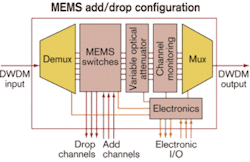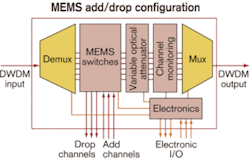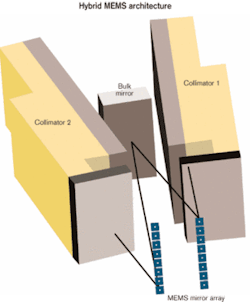MEMS is gearing up for the ROADMs ahead
The worst of the telecommunications shakeout may be over, but carriers have not returned to the level of network investment, or revenues, of just a few years ago. While capital has dwindled, technology has continued to advance. Network elements today deliver greater flexibility and performance. As a result, carriers-absent of rising income-seek tools with the potential to cut operational and maintenance costs.
Reconfigurable optical add/drop multiplexers (ROADMs) are among these tools. Like conventional fixed OADMs, reconfigurable devices determine the path of multiplexed wavelengths traversing a particular optical-switching node. Unlike their conventional cousins, however, ROADMs help improve network flexibility and cost-efficiency by allowing operators to switch optical paths remotely, instead of sending out a network technician to a node to install a new fixed-filter system.
The capability of ROADMs surpasses that of a simple optical switch. Depending on what technology forms their switching mechanism, ROADMs may offer additional features such as add/drop capability for all wavelengths, east-west operability, variable optical attenuation, dynamic power equalization, and remote monitoring of chosen wavelengths wherein data may be checked or modified before it travels on through the network. Most ROADMs can perform these functions on single wavelengths without affecting other wavelengths in the same fiber.
ROADM suppliers have seen a flurry of requests for proposals in recent months, driven largely by interest in automating metro networks. Compared to fixed OADMS, ROADMs require a larger capital investment-the sort of expense carriers once justified by promising a host of new revenue-generating wavelength services for end users. That dream, however, was deferred; under current market conditions, only the potential for lower operating costs could fuel the kind of interest that ROADM suppliers are now witnessing. And lower operating costs are precisely what ROADMs offer by transposing the flexibility and ease of control of SONET networks to the optical layer.
ROADMs adopt different switching fabrics to achieve this flexibility. The competing technologies include MEMS, planar lightwave circuits, wavelength blockers, and wavelength-selective switches (see accompanying sidebar, “Where ROADMs diverge”). Network architecture and application demands will determine which ROADM technology will dominate, but the winner will likely offer network engineers the following options:
• Pay as you grow. Rather than invest up-front in a large-channel-count system, carriers will favor ROADMs with scalable switch architectures and small up-front costs so that they can increase channels incrementally with escalating demand.
• Future expansion. ROADM switch architectures should not limit scalability.
• Protection and fault tolerance. Carriers will prefer ROADM switch architectures that can enhance network protection.
Of all the available switching fabrics, MEMS technology strikes the best balance between add/drop performance for all wavelengths and scalability. Before the industry downturn, MEMS technology attracted a great deal of interest-and suppliers-for both small- and large-scale optical-switching fabrics. At the time, optical crossconnects (OXCs) and add/drop modules represented the two most promising markets.
The downturn presented a profound setback for optical switches in general and MEMS in particular. MEMS suppliers that survived abandoned development of their optical products and returned to more traditional-and predictable-sensor applications. These vendors left behind a number of advances in micro-mirror technology, but news of these advances was largely drowned out by the market’s plunge.
During the network build-outs of the late ’90s, conventional wisdom suggested that MEMS needed to overcome challenges such as non-reliability, vibration sensitivity, high voltages, and optical losses. These allegations were largely accurate for early MEMS based on thin polysilicon mirrors. Several suppliers, however, had begun replacing this material with bulk-machined single-crystal silicon material. Bulk-machined mirrors are much thicker, making them more stable and highly resistant to influences of temperature, vibration, and fatigue.
Non-MEMS suppliers still assert that solid-state switches are intrinsically superior to MEMS, which have moving parts. But single-crystal silicon encounters almost zero fatigue even after a billion switch cycles-far more than the number of cycles that an actual operating ROADM will reach.
The operating voltages for MEMS are still high relative to alternate technologies, but they have dropped considerably from the 250 V of earlier systems. A 16×16 MEMS switch now requires about 100 V. MEMS require zero current because they operate on electrostatic forces.
Mirror losses due to scattering also diminished when single-crystal mirrors replaced polysilicon mirrors that were plagued with etched holes. Single-crystal mirrors are thicker-about 40 µm-and flatter, whereas polysilicon mirrors are typically 2- to 10-µm thick and curve over time. Most remaining losses come from array collimators, but collimator advances have helped control that. In general, carriers prefer switches delivering losses under 7 dB. Commercially available 8×8 MEMS switches deliver only 1 dB of loss; losses for 16×16 switches are limited to 1.5 dB.
Most of the early commercial momentum in optical MEMS revolved around low-port-count switches. That hasn’t changed: Carriers still prefer to make small capital investments for equipment they can scale up later as demand increases.
The first 2D 2×2 and 1×2 optical MEMS switches appeared several years ago, well before today’s ROADM designs had evolved. That timing has allowed MEMS technology to evolve alongside ROADM developments.
Consequently, modular MEMS arrays of 1×2 or 2×2 functioning as add/drop switches provide the simplest and most inexpensive upgrade for existing multiplexed systems with channel counts of 8, 16, 20, 32, and upwards. Scalability is built-in, with arrayed components such as collimators and tap couplers providing channel counts of 40 or more.
Input fibers carrying 32 channels, for example, can be demultiplexed by an arrayed waveguide or other demultiplexing element. Each output channel then becomes the input of each 2×2 switch, necessitating 32 2×2 switches. The other input to each 2×2 switch is the add channel for the corresponding wavelength, while the two outputs are the channel’s express and drop ports (see Figure 1).This architecture allows dynamic reconfigurability of all wavelengths. Array monitors can track express and drop channels and, with feedback electronics, can enable optimization of signal power for these channels.
Because 2×2 MEMS switches and monitors use arrayed optical components, the cost per channel is more economical with channel counts that are 16 and higher. Even when a supplier fits many channels into one package, the channels all share the same manufacturing and packaging cost. So packages with 16 or more switches are more economical.
Arrays of 1×2 add/drop switches offer slightly more ROADM flexibility (see Figure 2). Arranged as 1×2 switches, they drop incoming channels. Arranged as 2×1 switches, they add channels. Combining these modular arrays separates the add and drop functions into an east-west configuration for network protection. It also enables two counter-propagating rings, with one chassis dropping channels on the east fiber and adding channels on the west fiber, while another chassis reverses this arrangement. This architecture can also deliver add/drop capability of all wavelengths.MEMS is competing for low-port-count applications with alternate switching technologies, including wavelength blockers and wavelength-selective switches. It remains unclear which technology will dominate.
Five years ago, the MEMS OXC market was divided into two camps. One camp, targeting low-port-count applications, developed 2D MEMS arrays that inserted mirrors into an optical path running parallel to the chip surface. These MEMS mirrors operated in a digital mode; each of them was either deployed (on) or not deployed (off). Applications that required more ports used 3D MEMS, in which each mirror tilted on two orthogonal axes to steer the optical beam from one array to another.
The number of mirrors and/or switching paths required in a 2D matrix was N×M for an OXC with N by M ports: As port count increased, that led to ever-increasing path lengths, higher optical losses and path-length non-uniformities.
Conversely, a 3D MEMS OXC required only N+M mirrors for N by M ports. That not only reduced path-length non-uniformities, but it also allowed analog operation whereby optical signals could be attenuated if required or beneficial. The tradeoff for 3D MEMS was complexity and cost.Returning to the present day, carriers have begun to express interest in multichannel ROADMs that do not pre-assign a port for each channel. This task would once have required a 3D MEMS OXC configuration. Fortunately, MEMS designs have evolved alongside MEMS materials, and array collimators have helped create hybrid architectures such as the one shown in Figure 3 that combine the advantages of 2D and 3D arrays, namely:
•Small mirror counts as N by M ports require N+M mirrors.
•Mirrors that tilt on a single axis.
•Analog mode for variable-optical-attenuator functionality.
•Small path lengths reducing non-uniformities.
These hybrid configurations make effective OXCs, particularly for nodes where add/drop capability for all channels is not required but where the wavelength in each port needs to be interchangeable.
In such arrangements, the input ports of the OXC are both demultiplexed outputs and add channels, while the output ports of the OXC serve as express and drop channels. This architecture can also be split into an east-west configuration for network protection.
As carriers scale the ROADM technology in their networks to handle larger traffic volumes, more powerful and flexible switching matrices will find demand. Carriers are pushing ROADM suppliers for add/drop capability of all channels, but it is questionable whether most nodes will need that level of sophistication.
Metro networks, however, could benefit from ROADMs that enable any combination of wavelength channels to be steered to any single drop port for arrays of 32 or 40 channels. Ideally, every metro node would incorporate these switches, minimizing the need to roll out a truck to reconfigure channels.
The challenge is to make such a switch that is also nonblocking and highly functional in its first iteration. To meet metro price points, such switches will also need to be manufactured relatively inexpensively.Dr. John Auyeung is executive sales and marketing vice president at Chromux Technologies (Oxnard, CA). He can be reached via the company’s Website, www.chromux.com.
It is a safe bet that carriers will begin integrating ROADMs into their networks soon; it is less certain which switching fabric, if any, will dominate these systems. The competing technologies include MEMS, planar lightwave circuits (PLCs), wavelength blockers, and wavelength-selective switches.
PLCs are typically thermal switches that split incoming light along the two paths of a Mach-Zehnder interferometer. Heating one path elongates it and alters the phase of the traversing beam. The two beams recombine and follow a path according to how their phases interact. Like MEMS, PLCs allow fine adjustments to channel intensity. Their phase-based switching mechanism, however, can incur polarization-dependent loss.
Despite claims that PLCs are more compact than other switch architectures, a minimum bend radius is a limitation. Integrating conventional PLCs into an ROADM, therefore, may be limited to one or two devices given a 6-inch wafer. Also, factoring in yield may make PLCs less cost-effective. PLCs employing very-high-index materials show some promise, but high-index waveguides tend to have high loss.
Another switch architecture features wavelength blockers, which use either arrayed waveguides or free-space gratings to demultiplex light into discrete channels. Signals are then selectively expressed or dropped using an array of liquid-crystal shutters that block light via polarization or polarization rotation.
Wavelength blockers are particularly attractive at nodes dropping a small number of ports. Cascading arrays of these devices can create a simple, inexpensive switching fabric. This approach can become expensive, however, as port counts increase and/or if wavelength designations need to be dynamically changed. Also, such arrays can be susceptible to wavelength dependencies that cause bandwidth narrowing that could induce network loss. More stable lasers make this less of a problem, but wavelength blockers still pose multiplexing and demultiplexing problems that might belie their simple reputation.
Operating on principles similar to wavelength blockers except where blockers discard light, wavelength-selective switches redirect it into another fiber. A highly flexible and powerful technology, these switches can dynamically drop multiple channels per port. Their scalable architecture also allows future expansion while minimizing initial channel counts.
Wavelength-selective switches available now must be cascaded in multiple units to provide large add/drop capacity. Otherwise, they can add or drop perhaps eight out of 40 channels. Adding or dropping more channels requires an expansion port that can direct signals to a cascaded unit. But this sort of configuration is more expensive and increases loss, which requires more amplification.
There are enough network applications posing different demands to support different switching technologies. It is likely that one or more of these ROADM switching mechanisms will share a role with MEMS in future networks.
- Dr. John Auyeung



